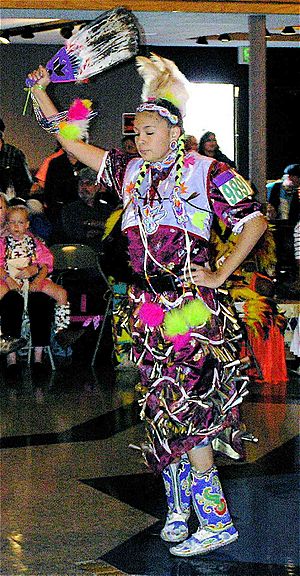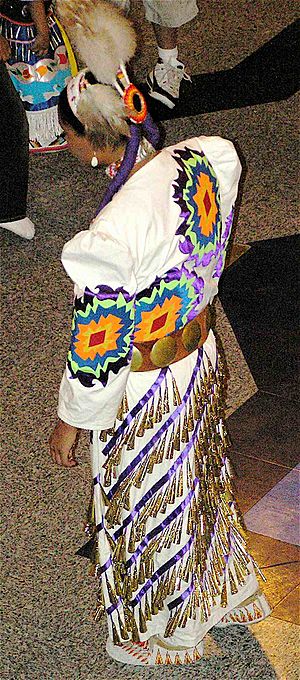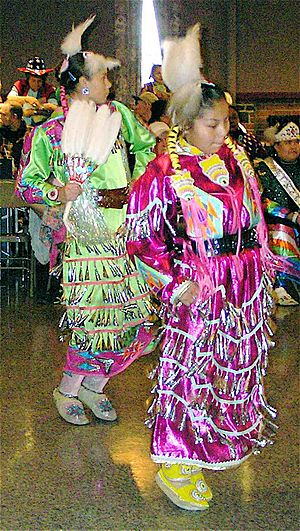Jingle dress facts for kids
The Jingle dress is a special outfit and dance for First Nations and Native American women. It's often seen at pow wows, which are gatherings where Indigenous people celebrate their culture. The dress has many rows of metal cones that make a jingling sound when the dancer moves. This dance is known as a healing dance.
Contents
The Jingle Dress Story
The Jingle dress and its dance began with three Ojibwe communities. These are the Mille Lacs, Red Lake, and Whitefish Bay Ojibwe. Around the year 1900, the dress and dance appeared in vivid dreams. These dreams came to a Midewinini, a traditional Ojibwe healer.
In both the Mille Lacs and Whitefish Bay dreams, four women wore jingle dresses and danced. The dreams also showed how to make the dresses. They gave instructions for the songs and how the dance should be performed.
A Healing Dream
In the Mille Lacs story, the Midewinini's daughter was very sick. After his dream, he and his wife made four dresses. He showed his wife how to dance. Then, he called the four women from his dream. He dressed them in the new outfits. At a dance, he told everyone about his dream. He explained how the women should dress and dance.
The drum started, and people began to sing. The women danced. As the evening went on, the sick daughter started to sit up and watch. Before the night ended, she was so moved that she began to follow the dancers. She was dancing around!
The Whitefish Bay story is very similar. In this version, the sick child was the Midewinini's granddaughter. A spirit in a dress appeared in his vision. The spirit told him that if he made this dress for his granddaughter, she would get well.
The healer made the dress. He brought his granddaughter to the dance circle. The first time around the circle, she was carried because she could not walk. The second time, she could walk but needed help. The next time around the circle, she was able to walk by herself!
Because of these stories, many women see the jingle dress as a healing dress. People sometimes give jingle dress dancers tobacco. They ask the dancers to pray for themselves or for loved ones who are unwell.
Over time, the jingle dress tradition spread. In the late 1920s, the White Earth people shared the jingle dress with the Lakota people. From there, it moved west into the Dakotas and Montana.
What the Jingle Dress Looks Like
Dance Steps
The traditional jingle dance uses light footwork. Dancers keep their feet close to the ground. They dance in a pattern. Their feet do not cross. They do not dance backward or turn a full circle.
Today, the dance can be fancier. Dancers use more complex footwork. The dress design often allows for these moves. Modern dancers might cross their feet, turn full circles, or dance backward. These moves show the differences between old and new jingle dress dancing.
The Outfit
Jingle dresses were first made from fabric in solid, "healthy" colors. These colors included red, green, yellow, black, and blue. Each dress had jingles on the sleeves and top. There were also one, two, or three rows of jingles on the bottom.
The first jingles were made from metal can lids. These were rolled into cone shapes.
Modern jingle dresses became popular in the 1980s. They use many different colors of fabric. The jingles are now made from tin or other metals. A child's dress might have 100 to 140 jingles. A woman's dress can have many more, depending on the design. Modern dancers often carry a feather fan. They might also wear eagle plumes or feathers in their hair.




